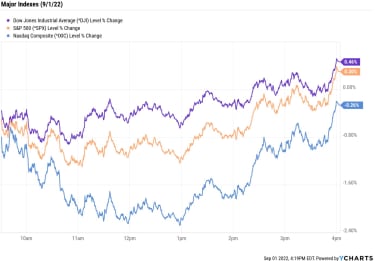Stocks kicked off September on a choppy note, though two of the major market indexes managed to push higher in the final minutes of trading.
Thursday’s early selling came courtesy of stronger-than-expected economic data that stoked worries the Federal Reserve will continue to be aggressive in raising rates and hold them higher for longer. Specifically, the Labor Department this morning said weekly jobless claims fell by 5,000 last week to a seasonally adjusted 232,000. Economists were expecting initial unemployment claims to arrive at 248,000. (Reminder: Tomorrow morning will see the release of the last nonfarm payrolls report – the most significant of the job numbers – to come out ahead of the Fed’s September meeting.)
Elsewhere, the Institute for Supply Management’s purchasing managers’ index (PMI) – a measure of manufacturing activity – held steady at 52.8 in July. “While that marks the lowest level in two years, that’s still better than expectations calling for a decline,” says Priscilla Thiagamoorthy, economist at BMO Capital Markets. “The details were also mostly positive with new orders clawing back into expansionary terrain, up 3.3 points to 51.3.” She adds that “supplier delivery improved to the best level since January 2020, suggesting easing supply constraints.”
Also weighing on the market was a major spike in the 10-year Treasury yield, which jumped 12.5 basis points to 3.257%, its highest level since June. (A basis point is one-one hundredth of a percentage point.) Rising rates and news that the U.S. government is restricting sales of certain chips to China and Russia delivered a hard punch to semiconductor stocks, with Nvidia (NVDA, -7.7%) and Advanced Micro Devices (AMD,-3.0%) ending sharply lower.
Sign up for Kiplinger’s FREE Investing Weekly e-letter for stock, ETF and mutual fund recommendations, and other investing advice.
As such, the tech-heavy Nasdaq Composite fell 0.3% to 11,785, its fifth straight loss. The S&P 500 Index (+0.3% at 3,966) and the Dow Jones Industrial Average (+0.5% at 31,656) managed to erase earlier losses to end the day with modest gains.
YCharts
Other news in the stock market today:
The small-cap Russell 2000 shed 1.2% to 1,822.U.S. crude futures slumped 3.3% to $86.61 per barrel as China initiated a new round of COVID-19 lockdowns in the city of Chengdu.Gold futures fell 1% to $1,709.30 an ounce, their lowest settlement since July 20.Bitcoin retreated 1.7% to $19,870.30. (Bitcoin trades 24 hours a day; prices reported here are as of 4 p.m.)Okta (OKTA) plunged 33.7% after the software company warned of issues arising from its acquisition of Auth0. Okta bought the identity platform for $6.5 billion back in May 2021, and the firm has faced challenges integrating the sales staff. “Sales integration problems were a primary headwind to billings [in Q2] as OKTA experienced elevated attrition rates from sales employees, causing disruptions and confusion in its go-to-market,” says CFRA Research analyst Janice Quek (Buy). “The company also saw longer sales cycles as a result of the macro environment. We cut expectations on its topline growth as OKTA tackles these challenges, but remain positive on the company on favorable prospects of the industry, OKTA’s market share in Identity, and the likely short-lived nature of current headwinds.”The Best Bargain Stocks Investors Can BuyIf it’s any consolation for investors, what goes down will eventually come back up. True, the market’s recent selloff stirs up familiar fears investors have had all year long, and plenty of uncertainty remains.
The drawdown could get worse before it gets better, says Dan Ashmore, investing expert at investment information website Invezz. “The only thing we know for a fact is that, historically, such large drawdowns often make for a good time to buy,” he adds. “With a time horizon long enough – and that is the key – it’s a nice time to buy.”
That sentiment is shared by Kiplinger columnist James A. Glassman. “Smart investors take a long view, both forward and backward. They look carefully at a company’s progress over the years and then try to forecast a decade out. With this kind of analysis, the 2022 decline is clearly a buying opportunity,” Glassman writes. With this in mind, he disclosed five of the biggest tech bargains to buy right now – each of which represents solid picks for long-term investors.
